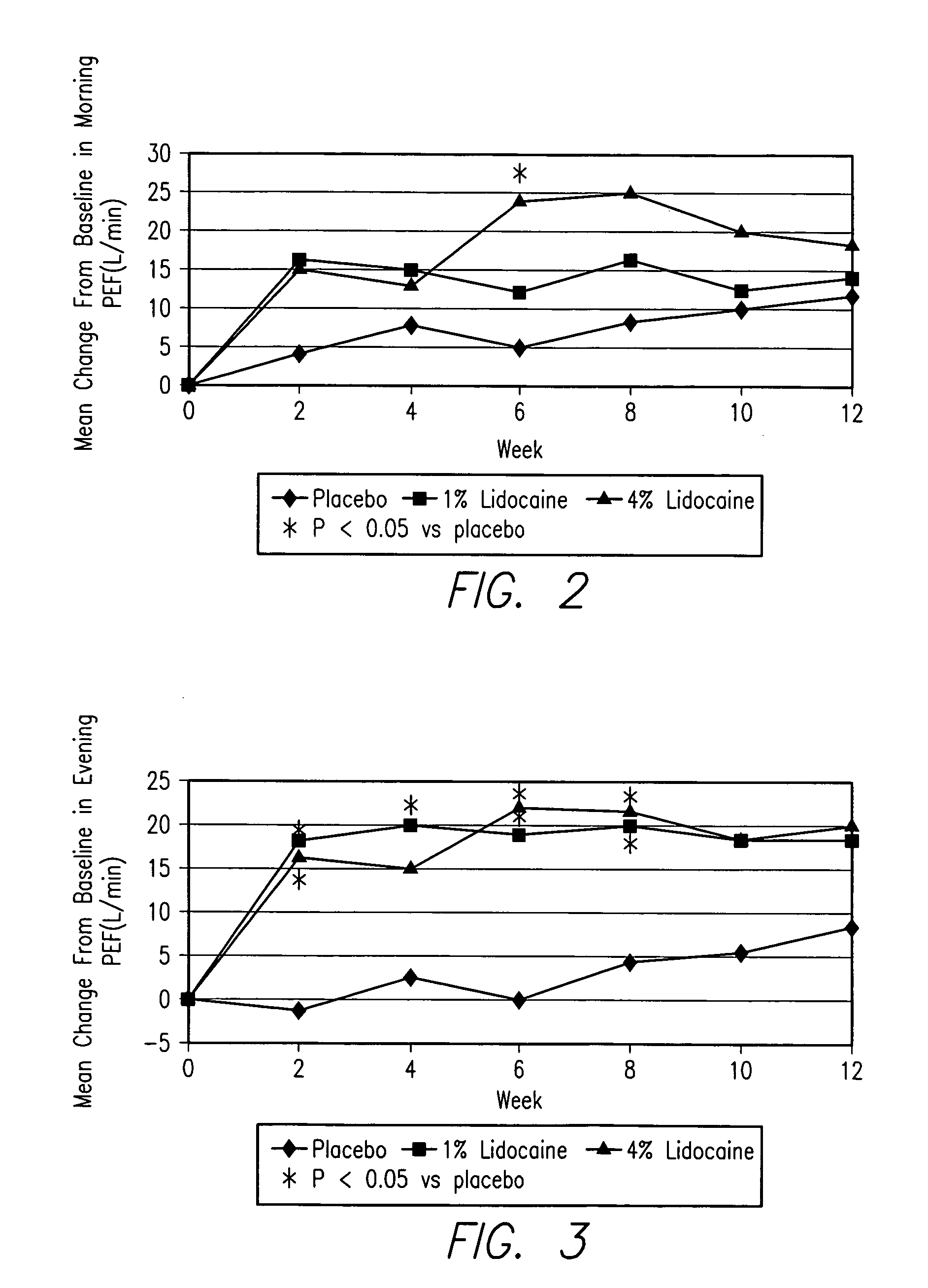Inhalable lidocaine formulation for treatment of asthma and for reducing the need for corticosteroids in asthmatic patients
a lidocaine and asthmatic technology, applied in the field of inhalable lidocaine formulations, can solve the problems of limited treatment options in this group, limited therapeutic success, and limited treatment options, and achieve the effect of reducing or eliminating
- Summary
- Abstract
- Description
- Claims
- Application Information
AI Technical Summary
Benefits of technology
Problems solved by technology
Method used
Image
Examples
example 1
Lidocaine Solution for Inhalation
[0269] This example describes lidocaine solution for inhalation used for in vivo studies.
[0270] LSI is provided as a 1.0 mL sterile, preservative free, nonpyrogenic single dose ampule. The ampules contain 10 or 40 mg of lidocaine hydrochloride, USP (1 mL 1% or 4% of lidocaine hydrochloride solution), in a pH range of 5.0 to 7.5. The added sodium chloride content is 6.844 g / L of sodium chloride, USP for 1% lidocaine and 0.351 g / L of sodium chloride, USP for 4% lidocaine. The osmolality for both solutions is approximately 275-300 mOsm / kg.
[0271] LSI is intended for use in combination with the PARI eFlow nebulizer. It is not to be used for topical, percutaneous injection, spinal or regional nerve infiltration, or intravenous administration. For dosing instructions, see the study specific protocol.
example 2
Preparation of Lidocaine Dry Powder
[0272] This example provides methods and procedures used for preparation of lidocaine containing inhalable dry powder.
[0273] For dry powder formulation of the invention, a purified lidocaine is processed to a powder having mass median average diameters ranging from 3 ìm to 10 μm by media milling, jet milling, spray drying, or particle precipitation techniques.
[0274] Media milling may be accomplished by placing lidocaine substance into a mill containing, for example, stainless steel or ceramic balls and rotating or tumbling the material until the desired drug particle size ranges are achieved.
[0275] Jet milling uses very high pressure air streams to collide particles with one another, with fine particles of the desired size being recovered from the mill.
[0276] Spray drying is achieved by spraying a fine mist of lidocaine solution onto a support and drying the particles. The particles are then collected.
[0277] Particle precipitation is achieved...
example 3
Dry Powder Inhalators for Lidocaine Dry Powder
[0278] The lidocaine dry powder formulations of the invention may be used directly in metered dose or dry powder inhalers.
[0279] A metered dose inhaler consists of three components: a canister containing the propellant lidocaine suspension, a metering valve designed to deliver accurately metered volumes of the propellant suspension, and an oral adapter which contains a spray orifice from which the metered dose is delivered. In the rest position, the metering chamber of the valve is connected to the drug suspension reservoir via a filling groove or orifice. On depression of the valve this filling groove is sealed and the metering chamber is exposed to atmospheric pressure via the spray orifice in the oral adapter and the valve stem orifice. This rapid pressure reduction leads to flash boiling of the propellant and expulsion of the rapidly expanding mixture from the metering chamber. The liquid / vapor mixture then enters the expansion cha...
PUM
| Property | Measurement | Unit |
|---|---|---|
| particle sizes | aaaaa | aaaaa |
| particle sizes | aaaaa | aaaaa |
| mass median aerodynamic diameter | aaaaa | aaaaa |
Abstract
Description
Claims
Application Information
 Login to View More
Login to View More - R&D
- Intellectual Property
- Life Sciences
- Materials
- Tech Scout
- Unparalleled Data Quality
- Higher Quality Content
- 60% Fewer Hallucinations
Browse by: Latest US Patents, China's latest patents, Technical Efficacy Thesaurus, Application Domain, Technology Topic, Popular Technical Reports.
© 2025 PatSnap. All rights reserved.Legal|Privacy policy|Modern Slavery Act Transparency Statement|Sitemap|About US| Contact US: help@patsnap.com


